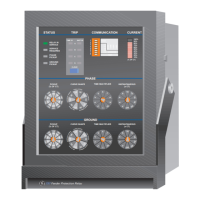GE Power Management
735/737 Feeder Protection Relay A-3
APPENDIX A A.3 DOs AND DON’Ts
A
A.3 DOs AND DON’Ts A.3.1 CHECKLIST
For accurate, reliable operation of the 735/737 it is imperative that the practices and recommendations listed below be
adhered to at all times.
1. 735/737 Grounding
Users are requested to ground the 735/737 relays to a solid ground, preferably directly to the main GROUND BUS using a
heavy gauge or braided cable. Do not rely on the metal switchgear enclosure to provide a solid ground. Each relay should
have its own path to ground. Do not daisy chain grounds together. See Section 2.2.6 SYSTEM GROUNDING on page 2–12
for more details.
2. Grounding of Phase and Ground CTs
All phase and ground CTs must be grounded. The potential difference between the CTs ground and the ground bus should
be minimal (ideally zero). If the secondary windings were not grounded capacitive coupling could allow the secondary volt-
age to float up to the voltage of the mains. This could pose a serious safety hazard.
To help shield the lines from noise a twisted pair is recommended for all CT connections.
3. RS485 Communications Port
The 735/737 can provide for direct or remote communication (via a modem). An RS232 to RS485 converter is used to tie it
to a PC/PLC or DCS system. The 735/737 supports Modbus RTU protocol functions 03, 04, 05, 06, 07, and 16. For more
information refer to Chapter 4: COMMUNICATIONS.
RS485 communications was chosen to be used with the 735/737 because it allows communications over long distances of
up to 4000 ft. Care, however, must be taken to ensure reliable trouble free operation.
• A shielded twisted pair (preferably a 24 gauge Belden 9841 type or 120 equivalent) must be used and routed away
from power carrying cables, such as power supply, contactors, breakers and CT cables.
• A termination resistor and capacitor in series (120 W / 0.5 W resistor and 1 nF / 50 V capacitor) must be used at each
end of the communication link. This matches the characteristic impedance of the line. The termination must be placed
across the A– and B+ terminals at the master and at the + and – terminals (H9 and H10) of the last relay on the com-
munications link. This is to prevent reflections and ringing on the line. If a different value of resistor is used there is a
risk of overloading the line causing erroneous, intermittent or no communications.
• It is highly recommended that the connection from the 735/737 to the interfacing master device be made without the
use of any stub lengths or terminal blocks. This is to minimize ringing and reflections on the line.
• The shield should only be grounded at one point. This is at the master. If it were to be grounded at more than one point
a potential difference between grounds might exist. This could create a ground loop. The shield must however be con-
nected to all 735/737 relays on the communication link (terminal H8). This is the floating ground for the RS485 port
which provides the ground reference as well as the reference for the internal noise suppression circuitry for the RS485
port.
• No more than 32 devices can co-exist on the same communications link. A repeater however may be used. It should
be noted that the 735/737 relays have only 31 unique addresses. As each device on the communication link must have
a unique address only 31 735/737 relays can be used on a single link. Other devices could however be used as well on
the link though.
• RS485 connections are made from the 735/737 + terminal to other devices B or + terminals and from the – terminal to
other devices A or – terminals.
4. Ground CTs
It should be noted that the 735/737 does not accept the GE Power Management 2000:1 CT which is actually a 50:0.025 CT.
Only CTs with 5 A or 1 A secondaries may be used
5. Front Panel Controls
Front panel phase and ground protection settings should not be altered while the 735/737 is in service. When these rotary
switches are positioned between settings, invalid information is passed to the relay’s microcomputer. To insure correct
operation of the 735/737, make sure all rotary switches are positioned properly.

